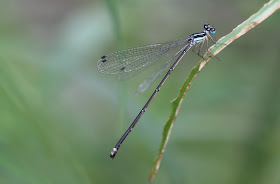No: 15 / Family: Calopterygidae / Genus: Mnais
Name: Mnais andersoni / Anderson's Greenwing / แมลงปอเข็มน้ำตกใหญ่ท้องขาว
Habitat: Upland, slow-moving clear streams
Province(s): Chiang Mai
In flight: March to June / Sightings (by me): Locally common
Province(s): Chiang Mai
In flight: March to June / Sightings (by me): Locally common
Easily confused with: Caliphaea angka; Caliphaea thailandica; Mnais yunosukei
One of the most beautiful damselflies I have seen is Mnais andersoni. I was lucky enough to see this species in all forms in Chiang Mai. They are quite large in size and like the Vestilas family, they are quite clumsy when landing. Both males and females were extremely common. They like to hang around trees and branches that overhang slow moving streams and live together in large numbers.
The male
There are two types of male and this one is an orange winged specimen. The fully mature male is highly distinctive with orange wings and a beautiful white thorax. It also has yellow/green markings along the prothorax (?). The end segments on the abdomen are also white.
The male close up
This shows just how beautiful the markings are on the male.
Young male
This is a young male that hasn't yet developed the white markings on the thorax.
The (other) male
The second male is the clear winged male (known as hyaline winged male). This one is similar to the orange-winged specimen but the wings and thorax colours are notably different.
Teneral male
The young male is a metallic green and has amazing white/cream eyes.
Can't take my eyes of you...
A good photo of the eyes (same specimen as above).
The female
The female is very similar to the male, but the abdomen is robust and the end segments are grey.
The mature female
This is a mature female, similar to above but has browned in colour.
A copula
This is a breeding hyaline pair.
A copula... again
This is a breeding orange winged pair.
I saw Mnais andersoni at a number of areas in Chiang Mai, up in the mountainous areas, along tree-lined streams. They were extremely common and I saw them from March-May while I was there. If you are in Chiang Mai you must go and see this species... it looks amazing close up. Many, many thanks, once again, to Noppadon Makbun for leading me to this species.

















+1163.jpg)






















+-+0798.jpg)
+-+2836.jpg)






+-+2825.jpg)



.JPG)
.JPG)



.JPG)




+-+2389.jpg)
+-+0859.jpg)